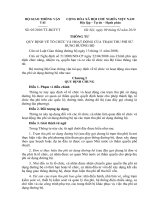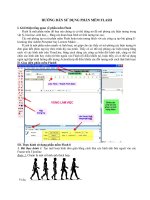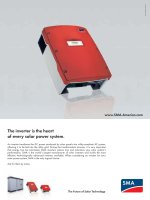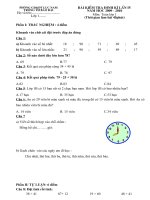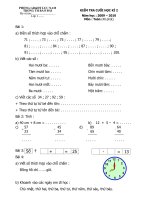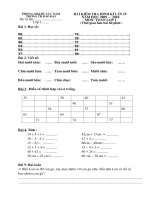Nuggets 05 2010
Bạn đang xem bản rút gọn của tài liệu. Xem và tải ngay bản đầy đủ của tài liệu tại đây (5 MB, 202 trang )
Nuggets of Gold
• Troubleshooting Tips For diagnosing
vibration problems
• Balancing
• Alignment
• Motors
• Pumps
• Signal Processing Considerations
• DC Drives
General Thought
WHEN HIGH VIBRATION
IS PRESENT
1: There may be a large force
2: The structure may be weak
3: Resonance amplification
may be present
Balancing
1: When balancing, plot the original and trial vectors on all
bearings and orientations. When all vectors point towards the
same solution; you are in the right plane. When the vectors
do not point towards the same solution, try another plane. If
this still doesn't work, try a multi-plane solution.
Vectors Agree In weight adjustment
Vectors disagree in weight adjustment
MOTOR GENERATOR SET ON DRAG LINE
SIX ROTORS WITH SEVEN SHARED BEARINGS SOLIDLY COUPLED ON A METAL DECK.
1
2
3
7 GENERATOR GENERATOR
NO. 1
NO. 2
ORIGINAL READINGS
BRG. 1
BRG 2
H 7.8 45 DEG
5.4 45 DEG
V 10.3 50
9.1 50
4
BRG 3
.8 80 DEG
9.7 45
5
MOTOR
GENERATOR
NO. 3
BRG 4
1.5 220 DEG
8.6 47
BRG 5
1.7 253 DEG
5.6 63
BALANCE SHOT ADDED TO No. 1 GENERATOR 8.25 OZ at 310 DEGREES
H 5.9 37
3.9 35
.6 45
.8 270
.9 270
V 11.0 45
9.6 45
10.1 36
8.8 40
5.4 45
6
GENERATOR GENERATOR
NO. 4
NO. 5
BRG 6
2.1 245 DEG
2.5 107
.8 270
1.1 117
BRG 10
2.6 260 DEG
5.1 180
1.1 45
5.9 200
After a weight was
installed,Horizontals went
down Verticals went down.
This is a strong sign that you
are adding weight to wrong
plane
NOTE !- LEVELS WENT DOWN IN THE HORIZONTAL DIRECTION, BUT UP IN THE VERTICAL DIRECTION
UNCOUPLED GENERATORS 1 & 2 FROM MOTOR
H 6.8 25
V 7.9 68
4.5 34
6.5 63
1.0 350
6.6 45
1.6 270
5.9 45
1.8 270
3.8 45
2.0 243
1.9 45
2.7 236
1.8 270
NOTE THAT EVEN UNCOUPLED, GENERATOR NO. 1 IS OPERATING WITH ALMOST 8 MILS OF VIBRATION
PERFORMED RESONANCE TEST- STRUCTURE FOUND TO BE OPERATING NEAR RESONANCE
ADDED 50 OZ BALANCE WEIGHT TO MOTOR , ALL LEVELS DROPPED TO BELOW 3 MILS.
2: When a rotor runs above its 1st
critical and there is an indication
of a bow, translate a portion of the
static balance component from
the ends to the center of the rotor.
If this is not done, the rotor will
run good on a balance machine
but bad in its own bearings at
high speed. This is due to
internal bending moments
produced by unbalance forces
acting on the axial distance
between the mass unbalance and
the correction weights.
BOWED FLEXIBLE ROTOR REQUIRING MID SPAN
SHOT
END PLANE SHOTS
CREATES INTERNAL BENDING
MOMENTS
MID SPAN SHOT
IF SHOT IS DIRECTLY ACROSS
FROM BOW NO BENDING MOMENTS
ARE CREATED.
WHEN A ROTOR OPERATES BELOW ITS FIRST BENDING MODE, IT ACTS LIKE A
RIGID BODY AND THE BALANCE WEIGHT CAN BE ADDED ANYWHERE ALONG THE
ROTOR. IF, HOWEVER, THE ROTOR OPERATES ABOVE ITS BENDING MODE, IT
BECOMES A FLEXIBLE ROTOR AND THE WEIGHT NEEDS TO BE PLACED OPPOSITE
THE HEAVY SPOT TO PREVENT INTERNAL BENDING MOMENTS.
CASE HISTORY: A STATIC BALANCE SHOT IN THE END PLANES WAS INSTALLED
ON A HIGH PRESSURE TURBINE ROTOR WITH A BOW. 18 OZ WERE ADDED IN
EACH END, WITH ALMOST NO EFFECT. WHEN WEIGHT WAS ADDED IN THE MID
SPAN, THE ROTOR WAS EASILLY BALANCED.
3: When balancing 2 pole
motors which are above 1000
HP, beware of thermal
vectors. This class of rotor will
operate well uncoupled, but
will often have high levels of
vibration when pulling full
current. This is because the
rotor can bow as a function of
heating by the current flow.
Corpoven Refinery
Venezuela
4: During a startup, if a high speed compressor
has low response as it passes through its
critical, but the level increases steadily with
RPM, without much of a phase shift, then
suspect unbalance in the coupling. On a polar
plot, the response line will point straight outward
because the amplitude increases without any
shift in phase.
COMPRESSOR WITH UNBALANCE IN COUPLING
PROBE
0
45
315
COUPLING IS OVERHUNG
PHASE
UNBALANCE IN COUPLING
90
270
AFTER
BEFORE
MAGNITUDE
135
UNBALANCE IN ROTOR
7000 RPM COMP.
BEFORE BAL.
3.8 MILS 240 DEG
WT. ADDED
23.7 GM @ 50DEG
AFTER BALANCE
.6 MILS 203 DEG
225
180
5: When balancing a large machine
with multiple rotors, if there is no other
clear indication, then on the first trial
weight attempt, add weight in the rotor
with the largest inertia. Learned from
Art Crawford. Once that is done, refer
to balancing tip No. 1
MOTOR GENERATOR SET ON DRAG LINE
SIX ROTORS WITH SEVEN SHARED BEARINGS SOLIDLY COUPLED ON A METAL DECK.
1
2
3
7 GENERATOR GENERATOR
NO. 1
NO. 2
ORIGINAL READINGS
BRG. 1
BRG 2
H 7.8 45 DEG
5.4 45 DEG
V 10.3 50
9.1 50
4
BRG 3
.8 80 DEG
9.7 45
5
MOTOR
GENERATOR
NO. 3
BRG 4
1.5 220 DEG
8.6 47
BRG 5
1.7 253 DEG
5.6 63
BALANCE SHOT ADDED TO No. 1 GENERATOR 8.25 OZ at 310 DEGREES
H 5.9 37
3.9 35
.6 45
.8 270
.9 270
V 11.0 45
9.6 45
10.1 36
8.8 40
5.4 45
6
GENERATOR GENERATOR
NO. 4
NO. 5
BRG 6
2.1 245 DEG
2.5 107
.8 270
1.1 117
BRG 10
2.6 260 DEG
5.1 180
1.1 45
5.9 200
NOTE !- LEVELS WENT DOWN IN THE HORIZONTAL DIRECTION, BUT UP IN THE VERTICAL DIRECTION
UNCOUPLED GENERATORS 1 & 2 FROM MOTOR
H 6.8 25
V 7.9 68
4.5 34
6.5 63
1.0 350
6.6 45
1.6 270
5.9 45
1.8 270
3.8 45
2.0 243
1.9 45
2.7 236
1.8 270
NOTE THAT EVEN UNCOUPLED, GENERATOR NO. 1 IS OPERATING WITH ALMOST 8 MILS OF VIBRATION
PERFORMED RESONANCE TEST- STRUCTURE FOUND TO BE OPERATING NEAR RESONANCE
ADDED 50 OZ BALANCE WEIGHT TO MOTOR , ALL LEVELS DROPPED TO BELOW 3 MILS.
6: Do not attempt to balance when the phase
is moving. This is a sign that there is a rub.
Machines that operate below a critical tend
to bow into the rub and the rub gets worse
with time. Machines that operate above a
critical can bow away from the rub causing
the phase angle to continually move against
rotation. Note that if a above critical
machine has a light rub, it can be a bad idea
to shut it down, because then it will have to
coast down through its critical speed.
7: When the horizontal and vertical
phase are the same or 180 degrees
out, then look for rocking or a loose
base. Another thing to consider is that
if a machine is operating between a
vertical and horizontal natural
frequency then his can also cause
unusual phase relationships between
the vertical and horizontal directions.
6 CASES OF LOOSENESS
Case History 1- The phase on a turbine bearing
was identical in the vertical and axial directions
with the axial vibration being very high. It was
discovered that one of the hold down bolts was
broken off beneath the surface of the concrete
allowing the bearing to rock.
Case 2- On a large fan, the horizontal and vertical vibration phase
angles were identical. The base bolts were loose allowing the bearing to
rock. The maintenance manager did not believe it so a cup of water was
poured on the base next to the bearing. When the water alternately shot
out from between the bearing housing and the base plate, he agreed to
have the bolts tightened. The horizontal vibration dropped from 12 mils
to less than 2 mils.
CASE 3- A power plant had spent $30000 on a mill motor trying to
get the vibration levels reduced. The rotor had been balanced
several times, but the amplitude was still high.
APPARENT COUPLE UNBALANCE IN A
FAN THAT OPERATES BELOW 1st
NATURAL FREQUENCY
POSSIBLE CAUSES
DISSIMILAR PEDESTAL STIFFNESES
– WRONG PLACEMENT OF VIBRATION PICKUPS
– LOOSE BASE BOLTS
– PHASE REVERSAL WITHIN ONE PICKUP
• NOTE- IF THERE IS A LARGE COUPLE COMPONENT IN A
FAN THAT OPERATES WELL BELOW ITS 1ST CRITICAL, THEN
BE VERY SUSPICIOUS AND AVOID INSTALLING A COUPLE
SHOT
EXAMPLE OF A LARGE FAN WITH
APPARENT COUPLE UNBALANCE
Vectors showed
what appeared
to be a large
amount of
couple
unbalance
SOLUTION
• The large couple component raised the level of
suspicion.
• The results of a previous balance person showed
the response to be highly non-linear
• The base bolt tightness was therefore checked
and all the bolts were all found to be significantly
loose.
• The bolts were tightened, the couple component
disappeared and the levels dropped to 1/4th their
original values.
• Following bolt tightening, the fan was then easily
balanced.
PLUNGER BOLT HOLDS BEARING TIGHT WITHIN HOUSING.
IF PLUNGER BOLT IS NOT TIGHT, THEN
BEARING WILL MOVE RELATIVE TO
HOUSING. THIS MOVEMENT RESULTS
IN A NON-LINEAR SYSTEM. BALANCING
IS VERY DIFFICULT, IF NOT IMPOSSIBLE
IN THIS SITUATION.
LOOSE BEARING IN HOUSING COMPLICATES
IF A BEARING IS LOOSE IN ITS
BALANCING
HOUSING, A NONLINEAR SYSTEM IS
CREATED AND BALANCING IS
BEARING ALMOST IMPOSSIBLE.
PLUNGER BOLT
2 MILS---SHAFT
17 MILS
BEARING HOUSING
CASE HISTORY
A LARGE ID FAN COULD NOT BE
BALANCED. THE CASING LEVELS
WERE SLIGHTLY OVER 2 MILS,
HOWEVER, WHEN SHAFT STICK
LEVELS WERE MEASURED, THE
AMPLITUDE WAS GREATER THAN 17
MILS. SINCE THE SHAFT TO INNER
BEARING CLEARANCE WAS ONLY 8
MILS, THIS MEANT THAT THE
BEARING HAD TO BE MOVING IN THE
HOUSING. WHEN THE PLUNGER
BOLT WAS TIGHTENED, THE CASING
LEVEL ROSE TO 21.5 MILS. AFTER
THE TIGHTENING, THE FAN WAS
EASILY BALANCED.
8: When balancing a rotor and the phase suddenly shifts 180 degrees,
then this is a sign that the rotor may be loose. Case History- While
balancing a large centrifuge, with a strobe light the vibration vector
changed from 3 mils at a given phase angle to approximately that amount
180 degrees out. The change was instantaneous. It was discovered
upon examination that the tapered fit of the shaft and bowl assembly was
loose.
Loose fit
between bowl
and drive shaft
